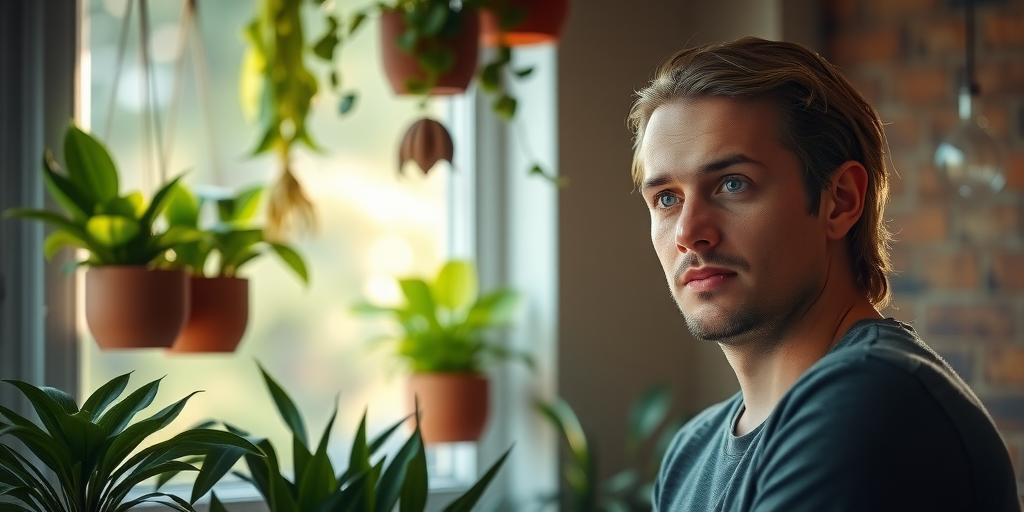
Top Air Purifying Low Light Hanging Plants for Fresh Indoor Air (2025)
Discover the best air-purifying low light hanging plants to freshen up your indoor space! These easy-care plants filter toxins, thrive in shade, and add greenery to any room.
Introduction
Did you know indoor air can be 5 times more polluted than outdoor air? Luckily, nature has a solution—low light hanging plants that purify the air while adding beauty to your home! Whether you have a dimly lit apartment or just want to spruce up your space with cascading greenery, these plants are perfect. They’re low-maintenance, resilient, and excellent at removing toxins like formaldehyde and benzene. Let’s explore the best air-purifying hanging plants that thrive in low light!
Why Choose Air-Purifying Hanging Plants for Low Light?
Improve Indoor Air Quality by Filtering Harmful Toxins
One of the biggest perks of air-purifying hanging plants is their ability to remove toxins like formaldehyde, benzene, and volatile organic compounds (VOCs) from the air. Studies from NASA have shown that certain houseplants can significantly improve indoor air quality, making them a natural and stylish alternative to air purifiers.
Perfect for Small Spaces—Hang Them in Corners, Bathrooms, or Offices
If you’re tight on space, hanging plants are a game-changer. They don’t take up valuable floor or shelf space, making them ideal for apartments, small offices, or even bathrooms. Plus, their trailing vines add a touch of greenery without cluttering your surfaces.
Low Maintenance—Ideal for Beginners or Busy Plant Owners
Many low light hanging plants are forgiving and don’t require constant attention. If you’re new to plant care or have a hectic schedule, these plants are perfect because they thrive with minimal watering and indirect light.
Enhance Aesthetics with Trailing Vines and Lush Foliage
Beyond their air-purifying benefits, hanging plants add visual appeal to any room. Their cascading leaves create a soft, natural look that complements modern, bohemian, or minimalist decor styles.
Best Low Light Hanging Plants That Purify the Air
Spider Plant (Chlorophytum comosum) – Removes Formaldehyde, Thrives in Indirect Light
Spider plants are one of the easiest air-purifying plants to grow. They’re excellent at removing formaldehyde (commonly found in household products) and produce baby spiderettes that you can propagate. They do well in low to bright indirect light, making them versatile for any room.
Pothos (Epipremnum aureum) – Filters Benzene, Grows Well in Shade
Pothos, also known as Devil’s Ivy, is nearly indestructible. It filters benzene (found in paints and plastics) and can survive in low light conditions. Its heart-shaped leaves grow long vines, perfect for hanging baskets.
English Ivy (Hedera helix) – Reduces Airborne Mold, Perfect for Bathrooms
English Ivy is a powerhouse when it comes to purifying the air—it’s particularly effective at reducing airborne mold. Since it loves humidity, it thrives in bathrooms where it can absorb moisture while keeping the air fresh.
Philodendron Heartleaf (Philodendron hederaceum) – Eliminates VOCs, Easy to Care For
The Heartleaf Philodendron is another low-maintenance option that removes VOCs. Its trailing vines grow quickly, and it adapts well to low light, making it a great choice for beginners.
Parlor Palm (Chamaedorea elegans) – Cleanses Air, Adapts to Low Light
Though not a trailing plant, the Parlor Palm does well in hanging pots and is excellent at filtering indoor air pollutants. It prefers indirect light but can tolerate lower light conditions, making it a great addition to dimmer spaces.
How to Care for Low Light Air-Purifying Hanging Plants
Watering Tips – Avoid Overwatering; Let Soil Dry Slightly Between Waterings
Overwatering is the most common mistake with hanging plants. Most low light varieties prefer their soil to dry out slightly between waterings. Stick your finger an inch into the soil—if it feels dry, it’s time to water.
Light Requirements – Bright, Indirect Light Is Best, but They Tolerate Low Light
While these plants can survive in low light, they’ll grow best in bright, indirect sunlight. If your space is particularly dark, consider rotating them occasionally to ensure even growth.
Fertilizing – Use a Diluted Houseplant Fertilizer Monthly in Growing Season
During spring and summer, feed your plants with a diluted liquid fertilizer once a month. Avoid fertilizing in winter when growth slows down.
Pruning & Maintenance – Trim Yellow Leaves and Propagate for More Plants!
Regularly trim dead or yellowing leaves to keep your plants healthy. Many hanging plants, like Pothos and Spider Plants, are easy to propagate—simply cut a healthy vine and place it in water until roots develop.
Where to Hang These Plants for Maximum Benefits
Bathrooms – High Humidity Helps Plants Like English Ivy Thrive
Bathrooms with natural light are ideal for humidity-loving plants like English Ivy and Philodendrons. The steam from showers provides extra moisture, reducing the need for frequent watering.
Bedrooms – Spider Plants Release Oxygen at Night for Better Sleep
Spider plants are great for bedrooms because they release oxygen at night, unlike most plants that do so during the day. This can contribute to better air quality and improved sleep.
Living Rooms – Pothos and Philodendrons Add a Tropical Touch
Hang trailing plants like Pothos or Philodendrons in living rooms to create a lush, tropical vibe. They’ll purify the air while adding a natural decorative element.
Offices – Low Light Plants Improve Air Quality in Workspaces
Offices with fluorescent lighting and limited natural light are perfect for low light hanging plants. They help reduce indoor pollutants from printers and furniture while boosting mood and productivity.
Common Mistakes to Avoid with Low Light Hanging Plants
Overwatering – Leads to Root Rot; Check Soil Moisture First
Many people assume hanging plants need frequent watering, but overwatering can drown the roots. Always check the soil before adding more water.
Too Much Direct Sun – Can Scorch Leaves; Keep in Filtered Light
While some light is necessary, direct sunlight can burn the leaves of low light plants. Keep them in shaded or filtered light to prevent damage.
Ignoring Pests – Watch for Spider Mites and Treat Early
Spider mites and mealybugs can infest hanging plants, especially in dry indoor conditions. Inspect leaves regularly and treat pests with neem oil or insecticidal soap if needed.
Using Poor-Quality Soil – Opt for Well-Draining Potting Mix
Heavy or compacted soil can suffocate roots. Always use a well-draining potting mix designed for indoor plants to prevent waterlogging.
Conclusion
Bringing air-purifying hanging plants into your home is an easy way to boost air quality, reduce stress, and add natural beauty—even in low light! Whether you choose a hardy pothos or a graceful spider plant, these green companions will thrive with minimal care. Ready to transform your space? Pick your favorite plant, hang it up, and breathe easier today!
